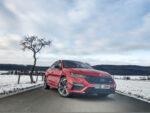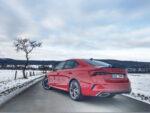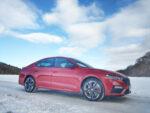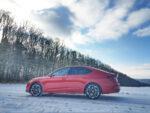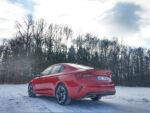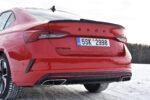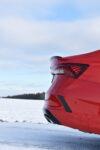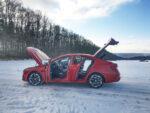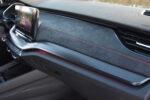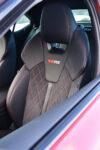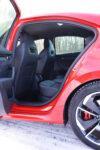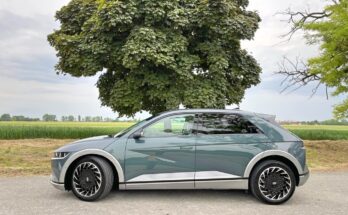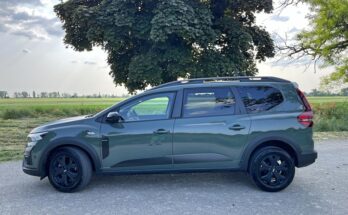Skoda Octavia and its top version RS have always enjoyed great interest, not only among Czech customers. It is therefore not surprising that even the fourth generation comes with this popular and tried-and-tested variant. The new "ereso" had its premiere with a novelty under the hood, which was a plug-in hybrid drive unit. Lovers of classic "burners" unfortunately had to wait a little longer.
With the positive experience gained from the previous generation of the Octavia RS 245 , I aimed for the gasoline variant in the new fourth generation as well. So we put the Octavia RS 2.0 TSI with a six-speed manual transmission and front-axle drive to the editorial test.
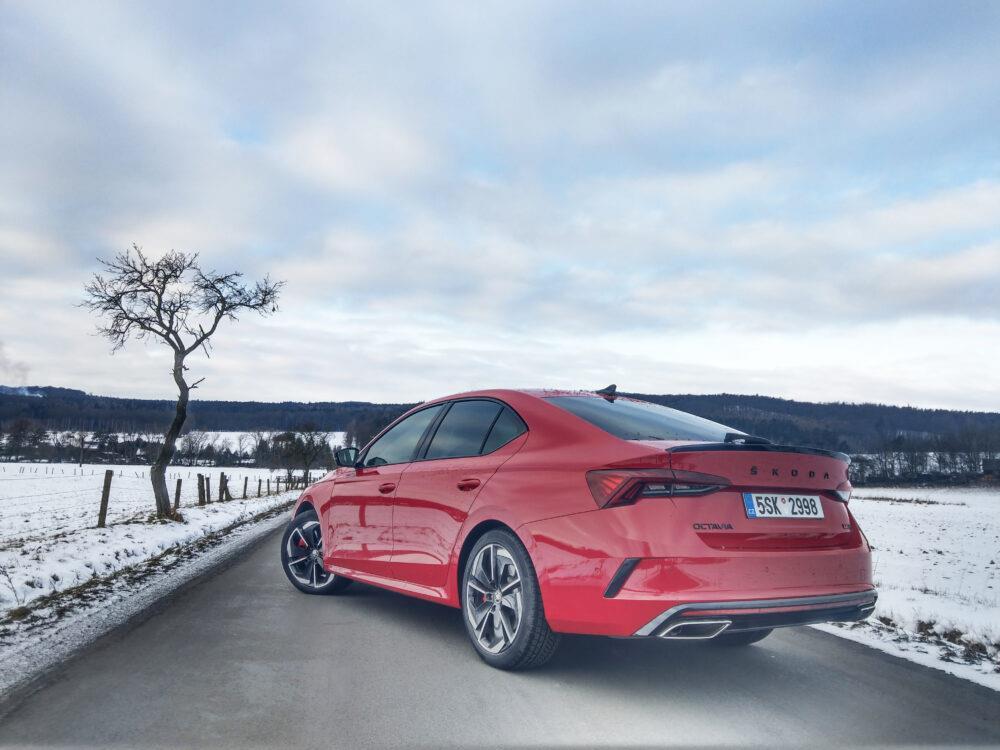
Exterior with RS elements
The new generation of Skoda Octavia fully follows the current design trend of the car company, i.e. the dynamic shaping of the body supported by very sharply cut lines. Skoda Octavia RS then successfully supports the announced trend and additionally enriches it with individual sports-tuned details.
These details include the black-painted front mask, or black-painted moldings around the windows, we also have more expressive sports bumpers, an elegant tear-off edge and the black-painted "SKODA" inscription on the trunk lid. The ubiquitous MS plaques are a matter of course.
The offer also includes 19-inch discs with a design that we already know from other "heresy" models, and which are an inherent part of these versions. Our car was fitted with "only" 18-inch rims, which slightly detracted from the car's overall dynamic concept, I suppose due to winter wear.
In terms of external design, it is hard to fault the "heresy", the fourth generation Skoda Octavia is a very good car in itself, and the RS version only refines it and enriches it with a sporty character.
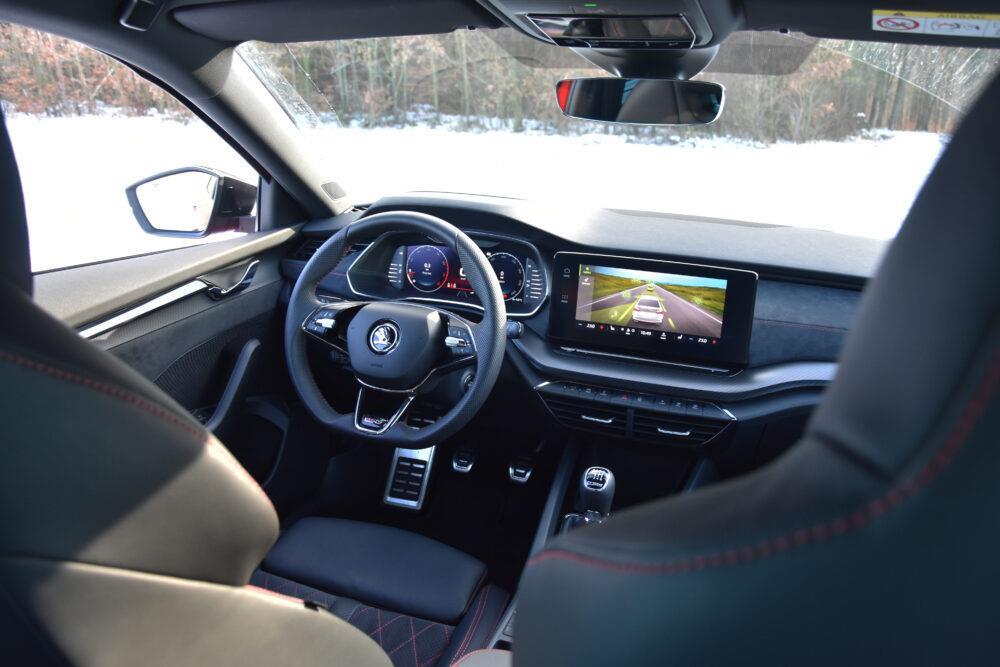
RS interior, imitation carbon and alcantara
The interior of the car is already traditionally spiced up with inherent elements falling under the RS trim level. Of course, there are distinctive sports seats with integrated headrests, which, with their shaping and processing, perfectly combine the requirements for a sporty and at the same time comfortable ride.
Furthermore, we have an abundant presence of alcantara, which is combined with elements imitating carbon within the dashboard. The RS version also has a three-spoke multifunction steering wheel, a black headliner, or elegant red thread stitching.
Fortunately, the fourth-generation Skoda Octavia still adheres to the principle of two separate fully digital displays, on-board infotainment and instrument panel. The dashboard itself looks very simple and airy. An elegant horizontal line clearly divides it into individual parts.
The instrument panel in front of the driver will offer a familiar fully digital environment where you can switch between different display styles. You can also change the displayed data inside the individual alarm clocks. Engine temperature and fuel level indicators are located on the sides of the display.
The on-board infotainment display (Columbus 10") controls functions such as driving assistants, air conditioning, audio system, car settings, telephone and, of course, navigation. This approach of controlling individual functions via the infotainment display brought about the previously announced and for me completely positive simplification of the dashboard.
There is a touch bar under the display itself, which can be used to control the radio volume in the new Octavia. A novelty that I have not learned to use until today and I always set the volume classically on the left roller within the multifunction steering wheel.
As part of the central tunnel, the tested Octavia RS had a classic six-speed manual selector, which I had no problem with. Its operation is precise and the tracks themselves are not long at all. In connection with the manual, I was a little longing for the classic handbrake.
In terms of internal dimensions, the intergenerational increase of the car will please. Octavia gained extra millimeters in length, width and height. The luggage compartment itself is also a strong point of the fourth generation, its basic volume offers a very respectable 600 liters.

Offered motorizations and driving impressions
Skoda Octavia in the RS version was first presented to us only in the iV version. This plug-in hybrid powertrain has become a novelty under the hood of the "heresy" Octavia and combines a gasoline fourteen and an electric motor. This powertrain gives the car a very respectable combined power of 180 kW and a torque of 400 Nm. Of course, the iV version brings certain positives and negatives. The possibility of emission-free operation or preferential parking speaks for it, while the significantly higher weight of the car or the absence of a reduced chassis speak against it.
Only with the passage of time did the variants offering classic internal combustion engines arrive on the market. The offer therefore includes the tested turbocharged two-liter TSI, which is available with either a six-speed manual or a seven-speed DSG automatic. In both cases, only the front axle is driven.
We also have a turbocharged diesel two-liter TDI, with an output of 147 kW and a torque of 400 Nm, always with a seven-speed DSG automatic, you can then choose between driving only the front or both axles.
We currently tested the petrol version, i.e. the 2.0 TSI offering 180 kW and 370 Nm of torque. The power unit further cooperated with a six-speed manual, which sent all the power to the front axle.
The tested two-liter engine retained the basis from the previous generation Octavia RS 245. The engine has currently only received certain intergenerational modifications aimed at its efficiency. However, the power and torque values remained the same. With a manual transmission, the petrol RS can reach 100 km/h in 6.8 seconds, with an automatic in 6.7 seconds.
For me, the gasoline engine is one of the cornerstones that creates an excellent and adequate driving experience in the RS version. Other elements inherent and exclusively for this motorization include the electronically controlled VAQ multi-plate differential, steeper progressive steering or a lowered chassis.
In terms of chassis, the "ereso" (except for the RS iV) is 15 mm lower to the road than the classic Octavia, and our tested car also had an adaptive DCC chassis, the range of which offers a really wide range of settings. You can then set its ideal position at will in the individual driving mode. The progressive ratio steering works great, with clear feedback from the front wheels.
The presence of the VAQ multi-plate differential is quite appropriate, it distributes 180 kW of power and 370 Nm of torque between the front wheels very effectively, the car does not lose grip under the accelerator and handles all exits from corners excellently.
The tested two-liter offers the traditionally quiet and refined operation, its performance is then very diverse and of course depends on how much you step on its neck. It takes a lot at low revs, and in the context of the tested manual, it simply doesn't force you to shift as much. He is certainly no stranger to sports pace. It also pleases with a fairly decent consumption, which usually ranges between 8-10 liters.
For me, the weakest link in the whole Octavia RS was the unnecessarily ambitious sound generator. Yes, you can get used to it over time, but the initial experience is very contradictory. "Ereso" artificially "grumbles" already in NORMAL mode, but in SPORT mode, the generator's efficiency is much more intense.
The artificial sound is then generated by the car's audio system and is therefore mainly intended for the crew inside. Fortunately, the sound generator can be turned off completely in the individual driving mode. The car is a little expressionless, but there are times when you need a break from the "Mustang" in the audio system.

In conclusion
The base price of the Octavia RS is CZK 889,900 including VAT. This is a "liftback" variant with a two-liter gasoline TSI under the hood and a six-speed manual. The cheapest Combi with this specification starts at CZK 929,900 including VAT.
For CZK 10,000 more, in both cases, you can buy a diesel 2.0 TDI with automatic transmission and front axle drive only. The plug-in hybrid version of the iV then costs CZK 50,000 more, and the most expensive specification is the two-liter diesel with automatic and all-wheel drive, liftback CZK 954,900 including VAT, combi CZK 994,900 including VAT.
The fourth generation Skoda Octavia RS very successfully continues the trend set by its previous generations. It is still a great-looking car that combines a sporty character with a large amount of comfort.
And what engine to choose? In the case of "heresy", I would go for the classics, namely the tested petrol, which I would rather combine with a seven-speed DSG automatic.
Source: Author's text
Image source: Author's own photos


